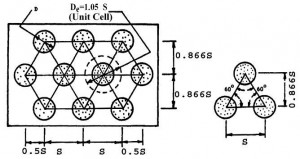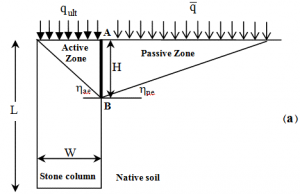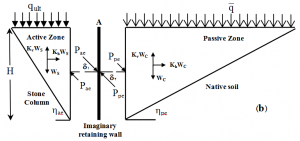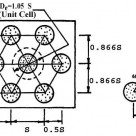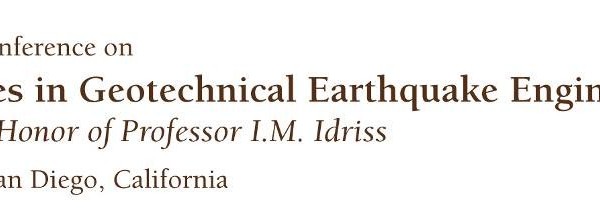دیوار حائل
Seismic Bearing Capacity of Stone-Column
Seismic Bearing Capacity of Stone-Column
Analytical Method for Seismic Bearing Capacity of Stone-Column
Reinforced Shallow Foundations
Javad Nazari afshar
Mahmoud Ghazavi
khashayar hemmati
ABSTRACT
Stone-columns is a useful method for increasing bearing capacity and reducing settlement of foundation soil subjected to structure loading. For stone-column construction, 15 to 35 percent of weak soil volume is usually replaced with stone-column material. Such columns may be constructed with various diameters, lengths, and center-to-center distances. This paper presents a simple method to determine the seismic bearing capacity of stone-column reinforced shallow foundation. For this purpose, a simple failure surface is assumed to characterize the failure stage of the stone column and soil materials using the concept of lateral active and passive earth pressures. The well known Mononobe-Okabe approach is used to represent seismic effects of soil lateral earth pressures. The results show that with increasing the earthquake intensity, the foundation bearing capacity decreases. Parametric studies will be presented to illustrate the role of contributing parameters such as geotechnical data of stone column material, foundation geometry, native soil specification, and earthquake details
INTRODUCTION
The use of stone-columns is a useful method for increasing bearing capacity and also for reducing settlement of soil under structures. In stone-column construction, usually 15 to 35 percent of weak soil volume is replaced by stone-column that usually has a special diameter and length and center-to-center distance. Design loads on stone-columns normally vary between 20 to 50 tons. The confinement of stone-column material is provided by the lateral stress induced by the surrounding weak soil. Upon application of the vertical stress at the ground surface, the stone and soil move downward together, resulting in stress concentration in the stone-column due to higher stiffness induced into the stone material than that induced in the soil. Stone-columns are constructed usually in triangular pattern or sometimes in square pattern. The equilateral triangle pattern gives more dense packing of stone-columns in a given area as shown in Figure 1
Three type of failure mechanism may occur in stone-columns. These are bulging failure, shear failure, and punching shear failure. In end bearing or free floating stone-columns, bulging failure extends to or greater than about than three times the stone diameter in length (Huges et al., 1974 &1976). The shear failure mechanism occurs in very short columns resting on a firm support either a general or local bearing capacity type failure at the surface (Madhav et al., 1978). The punching
shear failure occurs in floating stone-column at a length of less than about two to three times the stone diameter. This failure type may occur in end bearing stone columns embedded in weak soil underlying layer before a bulging failure can develop (Aboshi et al, 1979)
Fig1. Equilateral triangle pattern of stone columns
In this research by using an “imaginary retaining wall assumption”, it has been tried to develop a simple analytical method for estimation of the seismic bearing capacity of stone-columns assuming bulging failure mechanism.
BULGING FAILURE MECHANISIM
Stone-columns have length to diameter ratios equal to or greater than 4 to 6 and are embedded in homogeneous soil, the bulging failure occurs at a depth of about 2-3 times the diameter of the stone-column. This failure type was explored by performing field tests on stone columns (Hughes et al., 1974). A number of theories have been presented for predicting the ultimate capacity of an isolated, single stone-column supported by soft soil. Most of the early analytical solutions assume a triaxial state of stress which exists in the stone-columns while both surrounding soil and the stone-column material are at failure. The lateral confining stress () which supports the stone-columns is usually taken in this methods as the ultimate passive resistance offered by the surrounding soil. This passive stage is reached upon mobilization of the stone-column bulges which occur outward against the soil. Since the column is assumed to be in a state of failure, the ultimate vertical stress () which the stone-column (stone-column assumes to be cohesion less) can tolerate is equal to the coefficient of passive pressure on the stone-column () times the lateral confining stress (). This means:
where is the internal friction angle of stone-column material.
A number of relations for estimation bearing capacity of stone-columns have been presented by Greenwood (1970), Vesic (1972), Hughes et al. (1974), Datye et al. (1975), and Madhav et al. (1979) in the form of . These relations are similar to Eq. (1). Most of researchers have only tried to enhance the ability and reliability of relations in predicting the surrounding confinement pressure () in Eq. (1). For example, Vesic (1972) introduced the following expression for determination of the ultimate lateral resistance of the soil:
where is cohesion of the surrounding soil and q is the mean (isotropic) stress at the equivalent failure depth, and are cavity expansion factors given in a graph as functions of the angle of internal friction angle of the surrounding soil and the rigidity index,. According to Vesic (1972), the rigidity index is expressed as:
where E is the modulus of elasticity of the surrounding soil in which cavity expansion occurs and is cohesion of the
surrounding soil, u is the Poisson’s ratio of surrounding soil, q is mean stress within the zone of failure.
In the above equations, in addition to the ultimate lateral stress () and some geotechnical parameter such as c and fc , other parameters such as the modulus of elasticity and Poisson’s ratio of the surrounding soil are also required to determine the stone column bearing capacity. In addition, all above methods consider the static ultimate bearing capacity of stone columns. The authors are unaware of any developed analytical methods to determine the seismic bearing capacity of stone columns. In this article, a very simple expression is developed for calculating the seismic ultimate bearing capacity of single stone-columns undergoing a bulging failure type only by having common shear strength parameters of soils. The developed method is simply used for static analyses as well .
NEW SIMPLE ANALYTICAL METHOD
An imaginary retaining wall (AB) is used for estimation the bearing capacity of shallow foundation rested on sand as shown in Fig. 2. An active zone beneath the footing on the left hand side of the wall and a passive zone on the right hand side of the wall are assumed. This method was first introduced by Richards et al. (1993) for determination of the bearing capacity of shallow foundations resting on a homogeneous sand.
Fig2. Imaginary retaining wall conception
y:


